We believe learning should be fun, so we play a lot more games than we give tests. Games are one of my favorite ways to assess my kids’ knowledge in our homeschool. They are like a test that kids don’t even realize they’re taking! These are all review games we play to help us see how much we remember. But before we get to the games I have to tell you about what we play for. . .
House Points
In each of our games we are competing for house points. If you’ve been following us for long, you’ll know that we are big fans of Harry Potter. In the book series the students at Hogwart’s compete in a house points challenge all year long. They are all divided into houses, and anyone in the house can earn or lose points for the entire house. We keep little jars for each house in our homeschool. Our house points are tracked with little pinto beans. When my kids are on task, answering correctly, or being helpful and kind in our homeschool, they are awarded house points. (I don’t normally take house points away, although in Harry Potter, they do. That’s up to you to decide, but I like to keep things positive with our house points.)


We tally up our house points at the end of the year and the winner is awarded the House Cup! It is a goblet I spraypainted gold and added acryllic jewels to with a glue gun. It is about the size of our pencil containers, so the winner of the House Cup gets to use it as a pencil container and bask in the glory of the win! We award a winner each term, so the game goes on for about 4 months until we have a new winner.
No matter what game we are playing, the game points translate to house points.
My Big Book of Knowledge
I could easily buy random flashcards or trivia books, but my goal with our review games is mostly to see what my kids remember from the specific things we’ve learned. Instead I began compiling the important things we learn into a Big Book of Knowledge that serves as a “test bank” when I’m creating game questions.
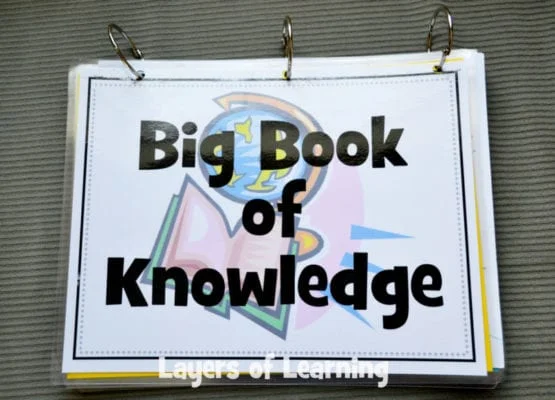
Building The Book
I began by 3-hole-punching a bunch of white card stock sheets and fastening them with 3 large metal rings. I added a cover and section dividers for each school subject. You can get the printable cover and section pages here.
These were printed on colorful card stock that I laminated. The laminated sheets are slightly bigger than the regular card stock, so between their bright colors and bigger size I can easily flip to the sections.

Anything we have learned may appear in the Big Book of Knowledge, and it’s the basis for many of our games, so the kids know they will do well to remember the things we add to the book.

They aren’t even necessarily in question form, but they help me remember what to include as I create questions for games. Some of my notes are done like anchor charts, like this one I created during our unit on First Civilizations.

Others of our pages are less visual, instead containing more substantive questions or notes. All of the questions below came from the first day we studied U.S. symbols and landmarks in Layers of Learning Unit 4-11.

I also add any songs, rhymes, or memory tricks we use.

Add To It Continually
The questions definitely get recycled over and over, but the book keeps growing each passing week, month, and year too, so there’s always fresh content. I keep the book on my desk and add a question or note or two every day from the topics we’re studying.
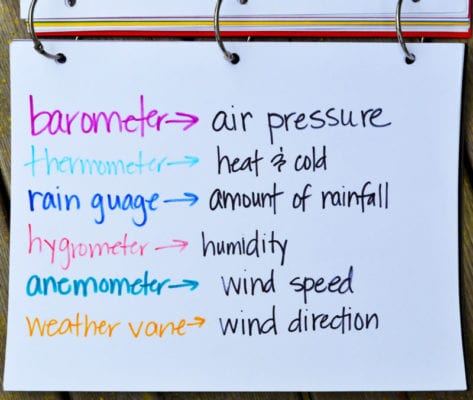
I’ve found that my kids are much more likely to commit information to memory when they know that they will be asked to recall it again. Memorizing is very intentional work. We must DECIDE to remember something and then REHEARSE the information in order to RECALL it on demand. The games we play give us a reason to do the work of remembering.
On to the games!
House Points Challenge
This is the most popular game at our house, and we play at least once a week, usually on Friday mornings.

During our House Points Challenge I ask trivia-style questions straight from our Big Book of Knowledge. Each of the kids have a little wireless Eggspert buzzer and the first one to buzz in and answer the question correctly earns a house point. If Daddy is home that day he gets in on the challenge too. . . and he never goes easy on them! These are the little wireless buzzers we bought to play with.
At first I was hesitant about the cost, but I’m telling you – they make the game ten times as much fun! Our kids LOVE the buzzers and they have been well worth it! You can click on the picture to see it on Amazon (affiliate link). Other than creating our Big Book of Knowledge, which I would do anyway, this game takes zero preparation and can run as long or short as you’d like.
Jeopardy
Jeopardy is one of our favorite review games. I use Jeopardy Labs to create the game board. Again, I use our Big Book of Knowledge to help me as I write the questions/answers. This one takes a bit of preparation, but it’s pretty fast to put together using my Big Book. I typically make the categories align with our school subjects, so there will be a category for each of our Layers of Learning topics as well as a “This & That” category with review from past weeks. We often play this in teams, pairing littles with their older siblings since it’s a little challenging. We also don’t enforce the Jeopardy answering with a question requirement (although we encourage it just for fun!).
Here’s a Jeopardy lab based on Layers of Learning Unit 1-1 for you to try.

Tic Tac Know
To play Tic Tac Know you just begin with a blank Tic Tac Toe board and your Big Book of Knowledge. Like the House Points Challenge, you’ll ask questions. This game alternates between two teams though. If Team 1 answers correctly they get to add an X to the board. If they miss, no X! Then the play goes to the other team. Each correct answer is given the opportunity to place their X or O on the board, trying to get three in a row before the other team wins.

If you only have one child, this is a great review game to play with a little modification. If he or she answers correctly, an X is added to the board and if not, Mom or Dad gets to add an O! Your kiddo has to get three in a row before Mom or Dad does.
We also like to play this with a beanbag Tic Tac Toe board my girls sewed a couple of years ago.

When you get a question right you get to toss the beanbag and try to get three in a row before your opponent. Here is a version you can buy if sewing isn’t your thing (affiliate link).
Flyswatter
To play Flyswatter you just need a some index cards and a flyswatter for each kid who’s playing. We play by choosing 4 to 6 answers that can stay the same throughout the round. For example, we’ve been learning about the heartland states – Wisconsin, Illinois, Indiana, Michigan, and Ohio – in Unit 4-10 this past week. I wrote each of the states down on an index card and equipped each kid with a flyswatter.
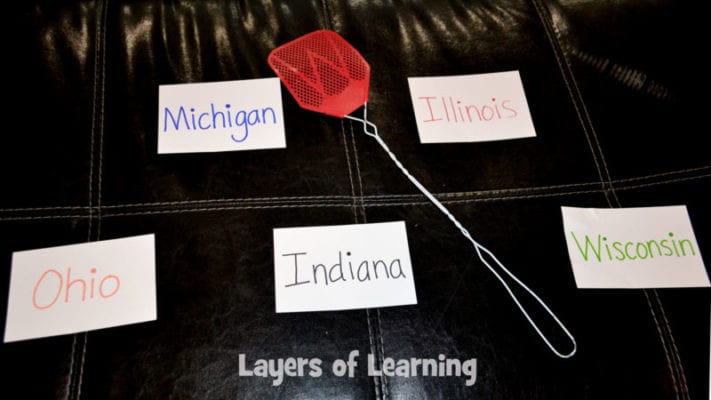
Then, thumbing directly through our Layers of Learning unit book, I spout little facts right from the unit book.
“This state is known as the Cheese state.”
“This state is famous for its deep dish pizza.”
“The capital city of this state was named for a famous explorer.”
“The Great Chicago Fire happened here.”
“This state is divided into two parts by one of the Great Lakes.”
Each time I say a fact, the kids have to quickly swat the right card before anyone else gets to it. The first flyswatter down on the correct one wins the point!
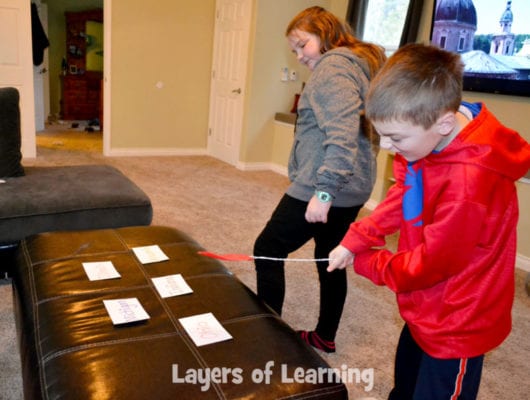
We keep going until I run out of facts. We do this frequently when we are reviewing geography and use a a variety of countries or states we’ve learned about. In history you can write the names of groups of peoples like Phoenicians, Egyptians, Greeks, and Romans on the cards, then state facts about each one. In science you could write things like the names of planets, each of the laws of motion, or various biomes and then give facts the kids have to associate with each card. For art, we play this using our printable art cards in place of index cards. I list an art movement or an artist and they must swat the matching painting first.
Kahoot
If you have teens with smartphones, Kahoot is a really fun way to review. Download the Kahoot app on each player’s device. You create the game questions ahead of time on their website. Again, I use our Big Book of Knowledge to help me come up with questions. These are all multiple choice style. Use a big screen so everyone can see (we use our laptop attached via HDMI to our TV). Each person can use their own device to select their answer. Then it displays the number of people who selected each answer, along with revealing the correct answer.
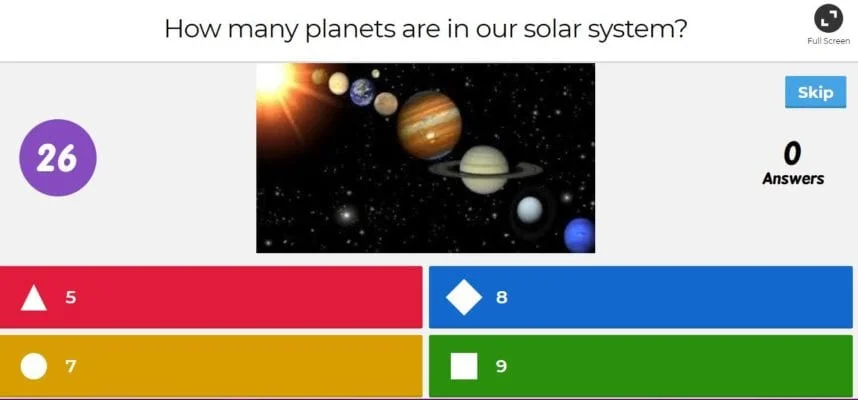
Battleship
Battleship is another really great game for a review. Again, just use your Big Book of Knowledge as your test bank. Play this with two people or teams. You can play using the actual board game (affiliate link) or use this printable version.

You begin with the kids marking where each ship is on their grid card. The player selects an easy, a medium, or a hard question. Correct answers to easy questions earn one shot at the enemy, correct answers to medium questions earn two shots, and correct answers to hard questions earn three shots. If she answers incorrectly, the play goes to the other player. Answer one question per turn, selecting a spot to fire on the opponent’s board. The opponent declares whether it’s a hit or a miss. A red X is placed on each hit on the board and a black O for each miss. Then the play goes to the next person. The game goes back and forth until someone has sunk all of the ships of their opponent.
Fishing
Go fishing! Print out our Fishing Game Template. Write in your own questions for whatever subject you’re studying. Cut out the fish, glue them onto card stock (you can use different colors to color code question subjects or difficulty) or print right onto card stock if you want the questions all the same color, then cut out again. Attach a metal paper clip or paper fastener to each fish on the end near the mouth.

Place the fish face down, so the question is concealed, in a “pond”. An empty plastic tub or a blanket spread on the ground make great ponds.
Now you need a fishing pole. Make one from a stick, a string and a refrigerator magnet. Tie the string to the pole then use hot glue to attach the string to the magnet.
Kids can take turns fishing for questions. If they get the answer right, they keep the fish. If they miss it, read the answer, and throw the fish back to try again.
Playing Really Can Be Learning
Our games are like a grand review. We all remember SO much more because we are constantly going over the things we’ve learned again and again. They keep our homeschool lighthearted and fun, and my kids just eat them up! Sometimes I have to pinch myself a little. I feel so blessed to spend all of my days growing, learning, and having fun with my favorite people. Hope you and your family enjoy some of these games too!
Get a Free Unit
Choose between the first unit in each Layers of Learning subject to try for free when you sign up for the newsletter.
We never spam and you can cancel your subscription at any time.





I love this idea so much! It seems like such a simple concept but it hadn’t occurred to me before. I am going to start our Big Book of Knowledge today! ?
I just discovered your curriculum a couple weeks ago and I love it! Plus your website is a treasure trove of useful information. We started unit 1-1 this week with Mesopotamia and my 7 and 5 year old have been very interested and engaged. Because they are so young I am spreading the unit out over the month and focusing on one section per week. Anyway, just wanted to say “Thank You” for such an awesome resource! ?
Such an awesome article!!! I loved all your ideas and am excited to implement! Gimme that buzzer!! 🙂
The link for the cover and divider pages isn’t working. Will it be updated soon??
April,
Sorry about that. The links are updated and you can download the printable now.
Just fyi, the National Zoo isn’t located on the National Mall in Washington, DC (saw that in your Big Book of Knowledge). It’s in Rock Creek Park, which is a couple of miles north of the Mall.
Yes, we’ve been there. Those were actually questions based on our family vacation to visit those sights, and we decided as a family to include the zoo in our personal book because it is Smithsonian-sponsored and we went to visit it along with all of the other Smithsonian museums at the National Mall on that trip. The zoo was a highlight for my kids, and they wanted to make sure it had a place in our book even though it didn’t warrant its own question. We are all aware of its location. 🙂
Your book and your questions can be your own. The beauty of this idea is that you get to personalize your “Big Book” to your own family and decide on your own questions and what to include for yourself.